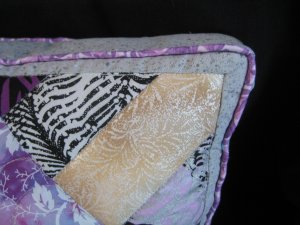Reader Joan asked what the heck I was doing with the double effort of needleturn applique on water soluble stabilizer. Of course, she asked *so much more* nicely. :-)
So, here's a more wordy explanation. I'm going to be using several different examples here to show what I'm talking about. One example is the flowers I did for my Moondance (designed by Beth Ferrier), one example is a single petal I did just to illustrate the steps and the last example is my Oz Jelly Roll top (which you can also see in the previous blog entry).
*Normal* people applique directly onto the base fabric. I have only recently become a fan of applique so my self-confidence is not at a high level. What if I don't put the applique in the right place? I know me .. I won't particularly want to remove the applique stitches and re-do them.

I thought of doing this water soluble stabilizer technique whilst I was working on a large pieced quilt that had lots and lots and lots and lots (ad naseum) appliqued flowers scattered all over the pieced background (Moondance by Beth Ferrier). I was absolutely *petrified* that I would put the "wrong" color flower in a particular spot. Since I was using a LOT of different colored fabrics for the flowers, I had no way of knowing what color combination I would be using in the future and it just could be that the flower I would make 1 hour from now would be more perfect for this spot where I just stitched a different flower! I wanted to be able to have ALL of my appliqued flowers available at the same time so I could then stand back and place each flower where it was best suited.
How to do this? Well ... I needed the flowers to be free-standing and fully stitched together. The water soluble stabilizer was my solution. Yes, in a way, I *am* kinda/sorta stitching the flower twice ... but from different point of view, this is just another way to prep the edges. (I absolutely, positively detest, detest, detest all the picky spray starch prep ... freezer paper templates ... other finicky methods. They drove me *crazy*.)
Here's the water soluble stabilizer. This specific one is Floriani's Wet-n-Gone. It's a fibrous stabilizer, looks like lightweight non-woven interfacing and handles like fabric. There are competitors with equivalent products.
Beside it is my scrap of applique fabric with the *FINISHED* edge marked in with a chalk pencil. (Use whatever marking method you like best. Sometimes I use a plain lead pencil. Sometimes a disappearing marker. Sometimes a Sewline pencil.)
I then trim the applique fabric closely .. about 1-/8" - 1/4" away from the marked line. This is the seam allowance that I am going to be sweeping under with my needle as the needleturn part.
What I've done here is needleturn the edge under, as marked by the chalk line.
I'm NOT doing an applique stitch at this point ... I am *basting* the turned under edge down with contrasting thread, which will be removed later.
While I do try to get a nice smooth curved edge, where appropriate, I'm not *overly* concerned about it because I know that when I do the real applique stitch, I can finesse the curves properly.
Then I trim the water soluble stabilizer.
(I couldn't stand that point in the top curved area. It look HORRID. I was embarrassed to show it to you. :-) So, I corrected it for this picture. :-) )
At this point, you have a choice: you can use the prepped piece this way and applique directly through the water soluble stabilizer OR soak the piece in hot water to dissolve the stabilizer so it won't be in the way. Remember, the edges have been basted down so they won't be popping back up.
For this example, I chose to soak the piece. This is what the back of the piece looks like after the stabilizer has been soaked and dissolved away ... voila .. it's all gone YET the edges are still secured!
And when this piece is actually appliqued in place, here is what it looks like.
BUT .. you could applique right through the stabilizer, which I did for the Oz Jelly Roll top.
Why leave the stabilizer in place? Oh, because I was just being lazy! :-)
When the quilt is laundered for the first time, all that stabilizer will dissolve away, leaving a lovely applique.
You see, if you want to dissolve the stabilizer, you soak the piece in hot water .. completely submerge it until it's all gone. It doesn't take very long .. 3 minutes? 5 minutes? something like that.
Then you have a wet, soggy applique piece. That means you need to dry it before you use it. You can air dry it on a cookie cooling rack, use your hand-held hair dryer or blot it & use your iron.
These are my Moondance flowers. You can see that there are several layers of fabric for each flower.
Where there was fabric-to-fabric, I did a real applique stitch to stitch the fabrics to each other. BUT where there was fabric-to-stabilizer (i.e. along the outer perimeter), I simply turned under the edges and basted. Once the stabilizer was dissolved, I had the most beautiful, free-standing flowers that I could then place whereever I wanted on the top.
In the end, I *am* doing double-duty .. one stitching to baste the piece to the stabilizer (and/or create the entire applique piece) and the final stitching which appliques the piece to the base fabric. The basting part is simply a different way of prepping the edges and is less tedious for *me* than other methods.
Oh, and the Moondance top? yes, I did eventually get it completed in August 2010! woo hoo! It's still waiting to be quilted .. I really ought to think more about doing that. :-)


































